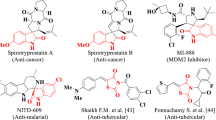Abstract
Herein, a new derivative of 1,2-naphthoquinone with semicarbazide and its Schiff base complexes and ternary complexes have been synthesized with some transition metals such as Ni(II), Co(II) and Zn(II) by using the conventional reflux method and 8-hydroxyquinoline (8-HQ) as a secondary ligand for ternary complexes. All the compounds were characterized using elemental analysis, molar conductance, melting point, Powder XRD, magnetic moment measurement and various spectral techniques such as FTIR, 13C NMR, 1H NMR, and Mass Spectra. The specific peak of the enolic proton in 1H NMR spectra of the tridentate ligand (L) explained the amido-iminol tautomerism in semicarbazone. In addition, powder XRD analysis and TGA confirmed the crystalline nature and the thermal study of metal chelates, respectively. In vitro, all the compounds were screened for antimicrobial (against bacterial strains: S. aureus and E. coli; Fungal strain: A. niger), anti-diabetic and anti-inflammatory activity with their obtained IC50 values and compared with Acarbose and Aspirin standard drugs. Bioactivities of azomethine containing free ligand (L), their Schiff base complexes and ternary metal chelates were compared to each other. Free Schiff base (L) was found most potent for all selective bioactivities compared to their all-metal complexes, except Ni (II) Schiff base complex showed excellent activity against C. albicans.







Similar content being viewed by others
References
Mustafa G, Zia-ur-Rehman M, Sumrra SH, Ashfaq M, Zafar W, Ashfaq M (2022) J Mol Struct 1262:133044. https://doi.org/10.1016/j.molstruc.2022.133044
Ali MR, Marella A, Alam MT, Naz R, Akhter M, Shaquiquzzaman M, Saha R, Tanwar O, Alam MM, Hooda J (2012) Indones J Pharm 23(3):193–202. https://doi.org/10.14499/indonesianjpharm23iss4pp193-202
Noreen S, Sumrra SH (2021) ACS Omega 6(48):33085–33099. https://doi.org/10.1021/acsomega.1c05290
Gomathi T, Karthik S, Vedanayaki S (2021) Indian J Chem 60A:26–36
Bahron H, Khaidir SS, Tajuddin AM, Ramasamy K, Yamin BM (2019) Polyhedron 161:84–92. https://doi.org/10.1016/j.poly.2018.12.055
Sumrra SH, Zafar W, Javed H, Zafar M, Hussain MZ, Imran M, Nadeem MA (2021) Biometals 34:1329–1351. https://doi.org/10.1007/s10534-021-00345-6
Canpolat E, Kaya M (2005) J Coord Chem 58:1063–1069. https://doi.org/10.1080/00958970500122565
Sumrra SH, Zafar W, Imran M, Chohan ZH (2022) J Coord Chem 75(3–4):293–334. https://doi.org/10.1080/00958972.2022.2059359
Sumrra SH, Mushtaq F, Ahmad F, Hussain R, Zafar W, Imran M, Zafar MN (2022) Chem Pap 76:3705–3727. https://doi.org/10.1007/s11696-022-02123-1
Rani S, Sumrra SH, Chohan ZH (2017) Russ J Gen Chem 87:1834–1842. https://doi.org/10.1134/S107036321708031X
Noreen S, Sumrra SH (2022) Biometals 35:519–548. https://doi.org/10.1007/s10534-022-00385-6
Basuli F, Ruf M, Pierpont CG, Bhattacharya S (1998) Inorg Chem 37(23):6113–6116. https://doi.org/10.1021/ic980424i
Farrell N (2002) Coord Chem Rev 232:1–4. https://doi.org/10.1016/S0010-8545(02)00100-5
Asif M, Husain A (2013) J Appl Chem 2013:1–7. https://doi.org/10.1155/2013/247203
Reis DC, Despaigne AAR, Da Silva JG, Silva NF, Vilela CF, Mendes IC, Takahashi JA, Beraldo H (2013) Molecules 18(10):12645–12662. https://doi.org/10.3390/molecules181012645
Singhal M, Paul A, Singh HP, Dubey SK, Songara PK (2011) Inter J Pharma Sci Drug Res 3(2):150–154
Živković MB, Novaković IT, Matić IZ, Sladić DM, Krstić NM (2019) Steroids 148:36–46. https://doi.org/10.1016/j.steroids.2019.04.010
Kumar S, Raj V (2013) Inter J Phytother 3(2):37–46
Singh HL, Singh JB, Bhaunka S (2016) J Coord Chem 69:343–353. https://doi.org/10.1080/00958972.2015.1115485
Liu H (2011) Traditional herbal medicine research methods. John Wiley & Sons
Pardee AB, Li YZ, Li CJ (2002) Curr Cancer Drug Targets 2:227–242. https://doi.org/10.2174/1568009023333854
Li CJ, Zhang LJ, Dezubw BJ, Crumpacker CS, Pardee AB (1993) Proc Natl Acad Sci USA 90:1839–1842. https://doi.org/10.1073/pnas.90.5.1839
Afrasiabi Z, Sinn E, Chen J, Ma Y, Rheingold AL, Zakharov LN, Rath N, Padhye S (2004) Inorg Chim Acta 357:271–278. https://doi.org/10.1016/S0020-1693(03)00484-5
Planchon SM, Wuerzberger S, Frydman B, Witiak DT, Hutson P, Church DR, Wilding G, Boothman DA (1995) Cancer Res 55:3706–3711
Shukla S, Srivastava RS, Shrivastava SK, Sodhi A, Kumar P (2013) J Enzyme Inhib Med Chem 28:1192–1198. https://doi.org/10.3109/14756366.2012.721783
Boothman DA, Trask DK, Pardee AB (1989) Cancer Res 49:605–612
Mahalapbutr P, Chusuth P, Kungwan N, Chavasiri W, Wolschann P, Rungrotmongkol T (2017) J Mol Liq 247:374–385. https://doi.org/10.1016/j.molliq.2017.10.021
Gomathi T, Karthik S, Vedanayaki S (2021) Ind J Chem 60A:26–36
Neelakantan MA, Marriappan SS, Dharmaraja J, Jeyakumar T, Muthuku-maran K (2008) Spectrochim Acta A Mol Biomol Spectrosc 71:628–635. https://doi.org/10.1016/j.saa.2008.01.023
Radha VP, Chitra S, Jonekirubavathi S, Chung IM, Kim SH, Prabakaran M (2020) J Coord Chem 73:1009–1027. https://doi.org/10.1080/00958972.2020.1752372
Shebl M, Adly OMI, Taha A, Elabd NN (2017) J Mol Struct 1147:438–451. https://doi.org/10.1016/j.molstruc.2017.06.085
Rajaa G, Butcher RJ, Jayabalakrishnan C (2012) Spectrochim Acta Part A Mol Biomol Spectrosc 94:210–215. https://doi.org/10.1016/j.saa.2012.03.035
Szklarzewicz J, Jurowska A, Hodorowicz M, Kazek G, Menaszek MEM, Sapa J (2021) Trans Met Chem 46:201–217. https://doi.org/10.1007/s11243-020-00437-1
Shinde UA, Phadke AS, Nair AM, Mungantiwar AA, Dikshit VJ, Saraf MN (1999) Fitoterapia 70:251–257. https://doi.org/10.1016/S0367-326X(99)00030-1
Acknowledgement
Department of Chemistry, University of Rajasthan, Jaipur, is gratefully acknowledged by all authors for its assistance and provision of research facilities. Also, we appreciate the Microbiology laboratory, SMS Medical College Jaipur, for biological investigations and MNIT, Jaipur, for spectral techniques and PXRD.
Author information
Authors and Affiliations
Contributions
Author Seema wrote the main manuscript text and Shobhana Sharma, Poonam Yadav and Suman Kumari contributed to data interpretation. All authors including corresponding author reviewed the manuscript.
Corresponding author
Ethics declarations
Conflict of interest
It is stated by the authors that they have no conflicting interests.
Additional information
Publisher's Note
Springer Nature remains neutral with regard to jurisdictional claims in published maps and institutional affiliations.
Supplementary Information
Below is the link to the electronic supplementary material.
Rights and permissions
Springer Nature or its licensor (e.g. a society or other partner) holds exclusive rights to this article under a publishing agreement with the author(s) or other rightsholder(s); author self-archiving of the accepted manuscript version of this article is solely governed by the terms of such publishing agreement and applicable law.
About this article
Cite this article
Seema, Sharma, S., Yadav, P. et al. Synthesis and structural elucidation of 1,2-naphthoquinone derivatives, Schiff base complexes and ternary complexes with 8-hydroxyquinoline: comparative studies of their antimicrobial, anti-inflammatory and anti-diabetic activities. Transit Met Chem 48, 389–400 (2023). https://doi.org/10.1007/s11243-023-00551-w
Received:
Accepted:
Published:
Issue Date:
DOI: https://doi.org/10.1007/s11243-023-00551-w




